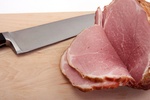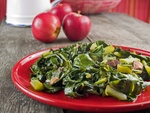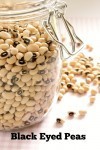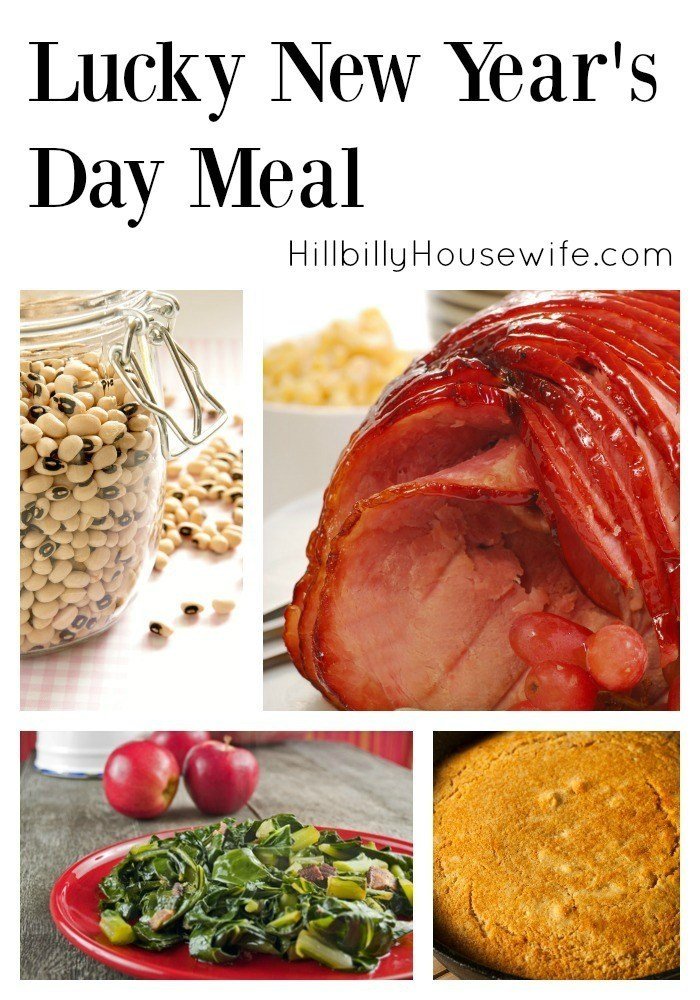New Year’s Day Lucky Meal
Down here in the South we cook a traditional New Year’s Day meal that’s supposed to bring good luck, fortune and wealth in the new year.
For us there are four components to the New Years Meal. Pork, Greens, Black-Eyed Peas and Corn Bread. Let’s break them down according to what they mean. This is what I’ve heard from the women in my husband’s family. There are some slight variations on this across the south depending on who you talk to. If you have a different luck meal tradition for New Year’s day, I’d love to hear about it.
Pork – For Prosperity And Plenty Of Food In The New Year
 Let’s start with the meat. Both here in the US and in Germany where I was born, pork is served for New Year’s Day. Back in the day, if you had a pig ready for slaughter, there would be plenty of food on the table for weeks and weeks to come. Pigs also root forward, making them a symbol of progress. Last but not least, if you were lucky enough to have a big ham on the table, you were pretty well off.
Let’s start with the meat. Both here in the US and in Germany where I was born, pork is served for New Year’s Day. Back in the day, if you had a pig ready for slaughter, there would be plenty of food on the table for weeks and weeks to come. Pigs also root forward, making them a symbol of progress. Last but not least, if you were lucky enough to have a big ham on the table, you were pretty well off.
I usually bake a ham on New Year’s day. Since I’m cooking my peas and collards from scratch, everything is ready at about the same time. If you’re in a bit of a hurry, and are using canned peas and greens, throw a few pork chops in the pan, fry them up and dinner is done.
Greens – For Money
Greens are also part of a traditional New Year’s Day meal. They are green like money (here in the US) and eating your greens on the 1st day of the year is supposed to insure there’s plenty of money all through the year. (As is standing outside right after midnight on the 1st of January with your wallet open … ) I’m not sure if it works or not, but I like collard greens and they go well with the ham I usually fix.
 I make a big batch of collard greens each New Year’s Day (and pretty regularly throughout the winter too). They are a tasty vegetable and despite the bacon used in the recipe, they’re actually pretty good for you.
I make a big batch of collard greens each New Year’s Day (and pretty regularly throughout the winter too). They are a tasty vegetable and despite the bacon used in the recipe, they’re actually pretty good for you.
If you don’t feel like stirring pots for two hours to make the greens on the stove top, you can also cook them in the slow cooker. Here’s my slowcooker collard greens recipe.
Black Eyed Peas – For Good Luck
Black-eyed peas are fixed and eaten for good look. I wrote about the history of these delicious little beans in the black eyed peas recipe I shared here on the blog previously. The gist of it is that the beans will sprout when put in the ground (indicating new growth) and will swell up significantly when cooked. Both of those attributes indicate good fortune.
Plus they are easy to store in their dry form and last throughout the winter, making them (like the collards) perfect food for the middle of winter.
For years I would just open a can of these peas New Year’s Day (the only time we ever had them), and we’d each eat a spoon or two full because it was tradition. Canned black eyed peas aren’t very good. Do yourself a favor and fix them from scratch using dried peas, onion, water and ham hock. A little butter to finish them doesn’t hurt either 🙂
Another traditional southern dish that includes these little peas is called Hoppin John. I don’t usually fix it on the first, but it’s very good.
Corn Bread – More Wealth
Once the ham comes out of the oven, my trusty cast iron skillet goes in to bake up a delicious, golden corn bread. One of the reasons I make it is because it goes well with everything else on the table. The other reason is because it’s yet another dish that is supposed to bring more money in the New Year. The finished corn bread looks like a big golden coin, doesn’t it? And according to tradition eating foods that resemble money on January 1st are supposed to ensure there’ll be plenty of the real stuff to go around throughout the year.
If you’re looking for some good cornbread recipes, I’ve got you covered. I usually make my best cornbread, but in a pinch, this plain cornbread will do just as well. Try them both and see which one you like better.
I better start cooking, but first let me wish you a very happy, healthy and prosperous New Year. 
To support the blog, check out the HBHW eBooks available on Amazon. Thank you!
Disclosure: Some of the links below are affilate links, meaning, at no additional cost to you, I will earn a commission if you click through and make a purchase.

